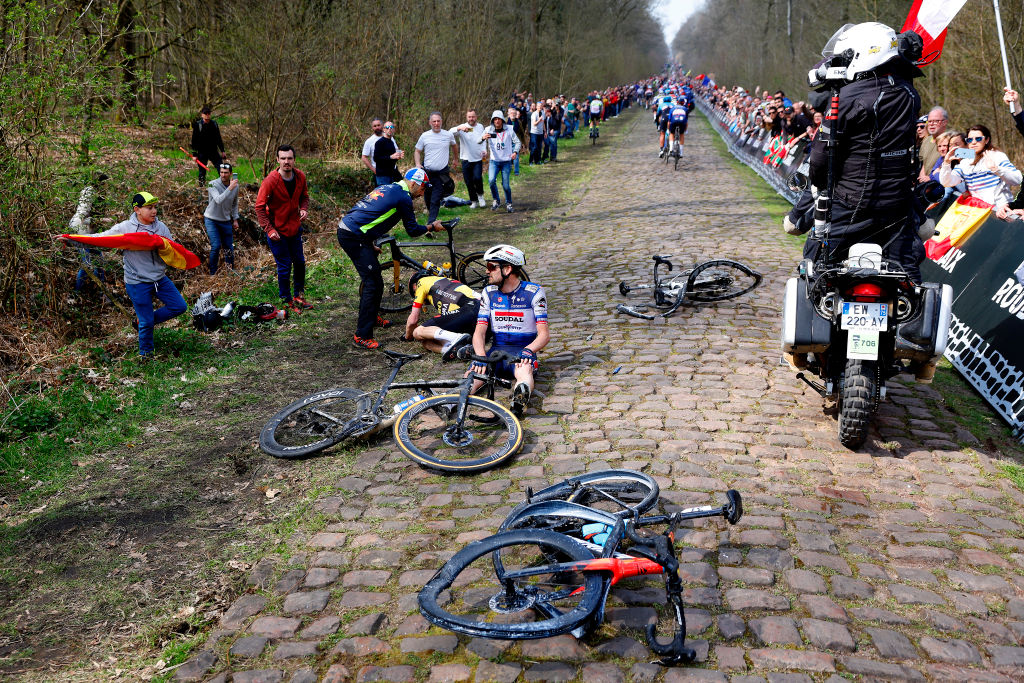
Paris-Roubaix could become less terrifying and somewhat safer for riders if the organisers ASO can convince local authorities to add chicanes to the road at the entrance of the Forest of Arenberg sector.
The peloton normally hurtles into this five-star sector of cobbles at 60 kilometres per hour, with riders sprinting down the fast and straight approach road to the cobbled sector.
The recent crash at Dwars door Vlaanderen, involving Wout Van Aert and many others have highlighted the dangers of high-speed crashes.
The Forest of Arenberg, also known as the trouée d’Arenberg, is the roughest and most treacherous stretch of cobbles in Paris-Roubaix. It is 2.3km long and often the site of crashes because riders come into the Arenberg forest with so much speed that any touch of the brakes on the slick pavé often leads to a fall. Kasper Asgreen and other riders were involved in a crash in the Forest of Arenberg in the 2023 Paris-Roubaix.
Yet everything could change this year and perhaps for ever.
According to L’Equipe, the Cyclistes Professionnels Associés (CPA) riders association has asked race director Thierry Gouvenou to find a way to slow the peloton before entering the Forest of Arenberg.
“I’ve raced here twelve times, and twelve times I’ve arrived in front of the trouée d’Arenberg wondering how I was going to make it out,” Gouvenou said, highlighting the dangers of this sector.
The latest race content, interviews, features, reviews and expert buying guides, direct to your inbox!
Gouvenou has some ideas on how to reduce the pace by adding a few turns or chicanes before the Porte du Hainaut that marks the entrance to the Arenberg forest.
“The idea is to add some turns to slow down the peloton and stretch it out, a bit like the chicane system on automobile circuits,” Gouvenou said on Tuesday during the official recon of the race route by race organiser ASO.
“Currently, they hit the Forest of Arenberg at about 60 km/h. If we could slow down to 30-35 km/h, it would be less risky. And that would highlight the difficulty of the Trouée too because the riders would arrive without momentum.”
Any change will have to be approved by the local authorities, however, because any extra turns or chicanes could also result in crashes before the pavé and local authorities are responsible for road design and ultimately sign-off race permits.
“I wrote to the riders, warning them that there would be greater braking before the Trouée,” Gouvenou explained.
“They told me that they preferred to brake hard and risk falling on the tarmac rather than entering the Trouée at 60 km/h.”
Speeds of Paris-Roubaix have risen sharply in recent years with the advance of aerodynamic equipment with the average speed record broken three times in the past six editions. The 2023 race ran at 46.84kph. more than a kilometre per hour quicker than the previous year’s record.
Fast race are expected in both the women’s and men’s races on Saturday and Sunday with possible tail winds and dry and warm conditions.
“The riders are a little on edge and are asking us for a little more security to enter the trouée, that doesn’t seem illogical to us,” Gouvenou said.
“But it may be necessary to think in the longer term, in particular about the bikes and equipment, which are the reasons for certain falls.”
Get unlimited access to all of our coverage of the Spring Classics- including reporting, breaking news and analysis from the Paris-Roubaix, Tour of Flanders and more. Find out more.

